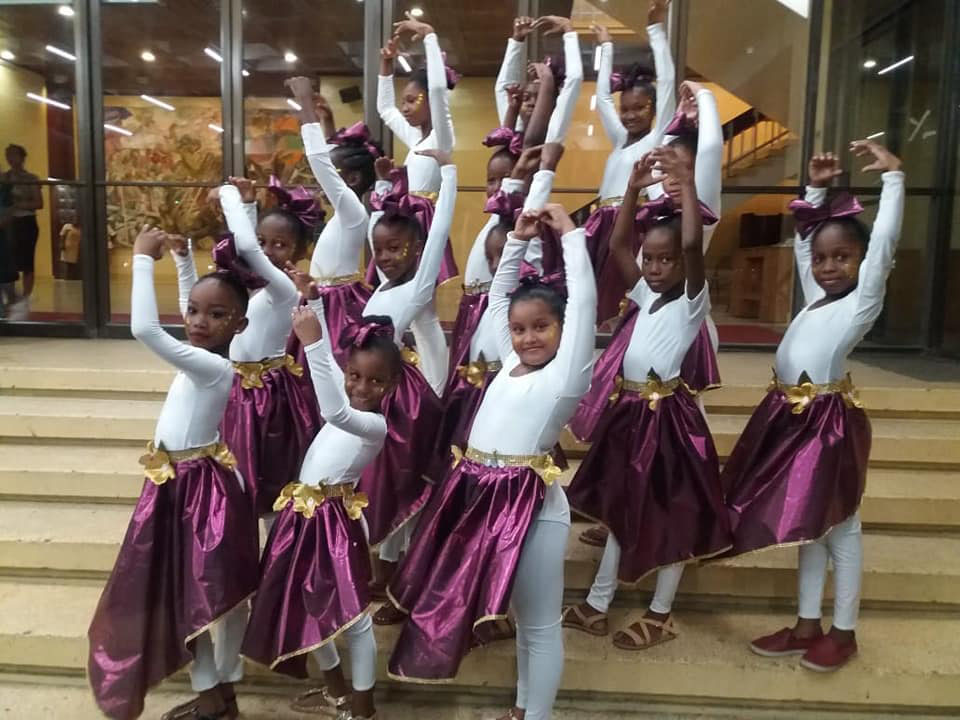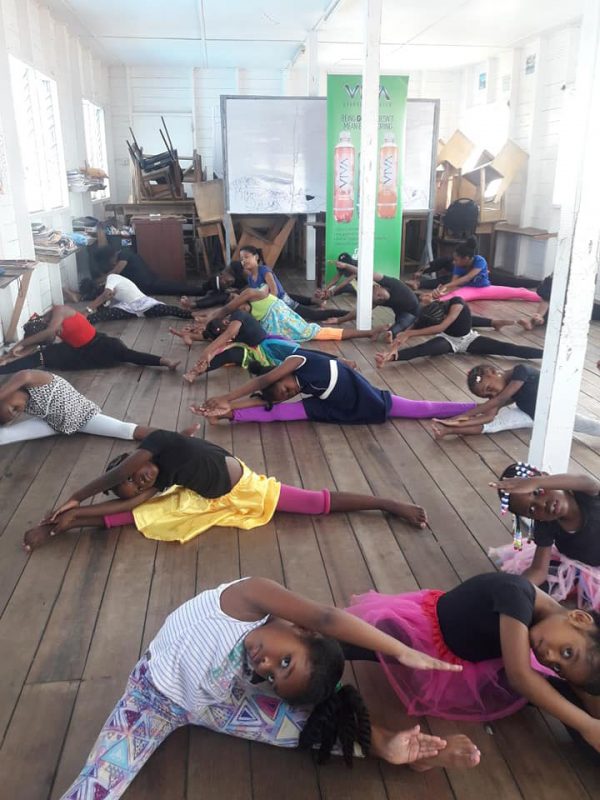“I always loved dance and dance was a hobby as a child growing up,” Natalie Adams said. “I wanted to do dance so badly and the person that was teaching dance would always say ‘girl you too stiff’ and even though she put me out of the group, I would go back to her. But I was never given the opportunity.”
Years later, Natalie became dance teacher of the same group and is today, one of Guyana’s most sought after choreographers.
The youngest of eight children, Natalie and her brothers and sisters were raised in a single parent home by their mother. But her mother died when she was eight years old, and she was placed in the church’s home (the House of Israel Headquarters) with other less fortunate children. She was the only one of her brothers and sisters who went to live at the home. As grateful as she was for them taking her in, Natalie said while she felt limited to things at the beginning of her life when her mother was alive, she felt even more so when she went to the home to live.
Though she liked dance, no one picked up on it to encourage her in the art form. She was also a talented singer and joined the church’s choir. Later, through the church’s pastor, she had the opportunity to become one of the contestants on Star Search.
But seeing dancers perform in church kept Natalie’s interest alive and she auditioned several times but was told by the teacher that she was not cut out for dancing. This did not stop her from being a bystander at rehearsals had every time she saw a new technique, she went home and perfected it. Even this, however, did not make a way for her to join the dance troupe.
Natalie then decided that when she was old enough to make her own decisions, she would find a school that would accept her. When she was 17, she was accepted at the National School of Dance (NSD).
In the run-up to the auditions, she recalled practicing all the genres of dance she knew which included Bollywood, Afro-centric and a bit of Soca. They were incorporated into her audition piece and she believes this led to her becoming a student at the dance school.
“Dance to me is like the air we breathe, the expressing and giving of oneself, connecting with others you’re entertaining,” she shared.
It was after she had been at the NSD for some time that Natalie was asked to teach the church’s dance troupe while the teacher was abroad. Asked whether the woman was impressed with how she turned out, Natalie said she did not think so and her incorporating more contemporary routines and outfits for the dancers may have made the woman less tolerant of her. The teacher, she further said, never returned to teaching the group.
“I believe in presentation. From the time, the audience see the dancers and the style of clothing they are wearing, they must be like ‘wow!’ and be looking forward to the performance that they put on,” she said.
“When I began teaching, I was in my early twenties. Even while I was pregnant with my daughter, I was still teaching dance and still dancing. I was teaching at several schools – Mae’s Primary School, Green Acres Primary, St Margaret’s Primary then I began teaching secondary schools as I became popular. But, despite all of this, I was not this fantastic dancer. I would look at my other colleagues and be like ‘wow, this person is remarkable’.
“One day I was in class [at NSD] listening to my teacher Vivienne Daniels and she said, ‘Not all good dancers are good choreographers and good choreographers are not always good dancers. Hence, you can know all the techniques, you can teach them but yet you cannot execute it’. After this I looked at myself and asked myself in which category I fit because I was dancing and teaching dancing and seeing that I was raising the level of dance, yet I wasn’t this fantastic dancer. I brought out a fantastic dancer in my daughter and every year since she was little, she has been winning at the Mashramani competitions, and now she is 19 and a member of the National Dance Com-pany.”
She boasted that her class of 20-plus children participating in the Mashramani Children’s Competitions later this month have been learning their routines since last September and are already versed in all that they have to do. Their outfits have been underway since last year and Natalie gave credit to her seamstress, Sunita, who has always been there for her in this respect.
Most of their dances are Afro-centric, contemporary or social commentary. Social commentary focuses on societal issues and has both drama and dance in it. She uses dance to bring a positive message to the issue. Dance is everything to Natalie but so is the message. Therefore, she steers away from teaching her children Soca dances as she does see how much of a positive message this can relay to an audience adding that for her, it is most times not a genre of substance.
“With this age that we’re living in, it is of more [importance] now to send a positive message and to give hope to those watching. I am not on the stage dancing but when I’m done fashioning these children, it’s like I’m right up there with them. All that you cannot do, you can still fashion it into them and still see your glory. I always tell my children that if I cannot connect with them, then the audience cannot connect with them. Many times, at the end of their performances, people in the audience are crying because that is how relatable I try to make each piece,” she said passionately. Being able to bring out the best in her students has often won her first place. If she should come second one year, Natalie said, the winner should not sit comfortably because the next year she was going to win as she would make it her assignment to study their weak and strong points then come better the next year. In fact, the woman said, it is not just about winning for her, but knowing that she did better than the previous year.
The choreographer said there are many dance schools and classes where teachers prefer their students to do what are called company movements or basic routines instead of teaching the children anything advanced. But if Natalie realizes a child has the potential to do advanced movements, she does not limit that child, but instead offers encouragement, then works with the child consistently on perfecting it.
There are children, too, she noted, who are difficult to teach, who are sometimes even stiffer than she was. But because of her own experience, she puts in the extra effort to polish them, to encourage them and to make their dreams of being a dancer come true.
Noting that society is not supportive of the art, Natalie said what may be responsible for this is because people look at the art form and believe that it cannot pay to dance. And while this is partially true, it is not entirely so, she said as she sustains herself and two children while being a single mother through teaching dance. While not many persons see the importance, Natalie said, it is these same people who expect entertainment.
A theatre built specifically for all forms of art should help with people seeing more value in them. Also, teaching dance at the foundation level, specifically nursery schools, will not only build the interests of both children and parents but will also better hone the skills of those who take it up, she added. One of the most recent developments of this in schools was the introduction of Theatre Arts at the Caribbean Secondary Education Certificate level in the last decade.
“Dance is a sport and it helps to balance your child. There are some children who would have trouble finding this balance. Being an academic teacher at the nursery level also, I know how important it is to do well in both academics and dance. I would check the report books of my students from time to time and if they are not doing well, they have to sit out of practice until they can improve on their grades,” she said.
As a dancer, Natalie follows a diet of lots of fruits, vegetables and fish. She drinks lots of water as well. This same diet is followed by her children.
Natalie said she dances all the time, even in her kitchen sometimes when her kind of music is on, “even if it means that it’s just my big toe dancing,” she laughed.
During the school term, the teacher works with two groups of children at two different sessions in the afternoons on school days while weekend sessions cater for her secondary school dancers. In the next five years, she hopes to have her own dance studio that is open to everyone including senior citizens who may be interested. For the time being, Natalie is hired outside of school to teach private groups and even couples wanting to learn to dance for their big day.
She advises persons wanting to take up the art to give the best of themselves and to never stop trying to be better. She encourages individuals that taking up dance as an extracurricular activity or any extracurricular in general will help to make a person rounded. In addition, she admonished persons to travel, see the world, mix with other cultures as it will help them to make wiser decisions. Natalie said she always to tells her children that “experiences make people wiser but it doesn’t have to always be your own experiences, learn from other people’s mistakes when you can instead of making the same decisions you know led them to trouble.”
This Capricorn likes the colour black. She fancies cooking, interior decorating, and watching dance competitions.
Natalie can be followed on Facebook, where videos of many of the dances she choreographed are posted. Her students will be part of the Mashramani Children’s Competition slated for the National Cultural Centre beginning on January 27, at 10 am.










